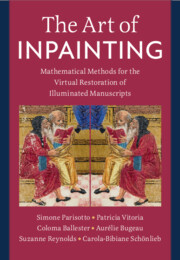3 - Non-Local Inpainting Methods
Published online by Cambridge University Press: 22 May 2025
Summary
Chapter 3 provides a historical view of non-local inpainting methods, also called examplar-based or patch-based methods. These approaches rely on the self-similarity principle, i.e. on the idea that the missing information in the inpainting domain can be copied from somewhere else within the intact part of the image. Over the years. many improvements and algorithms have been proposed, enabling us to offer visually plausible solutions to the inpainting problem, especially for large damages and areas with texture.
Keywords
Information
- Type
- Chapter
- Information
- The Art of InpaintingMathematical Methods for the Virtual Restoration of Illuminated Manuscripts, pp. 52 - 114Publisher: Cambridge University PressPrint publication year: 2025
